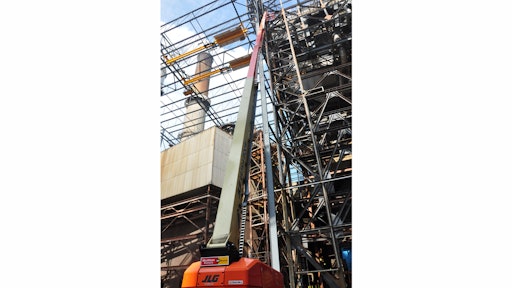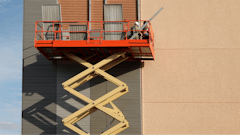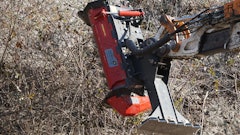
The past couple of years has seen the introduction of self-propelled boom lift models reaching heights of 180 feet and above, giving workers access to a work envelope of over one million square feet of space. For their part, atrium lifts with working heights up to 170 feet continue to be a growing product in North America, taking workers into settings and spaces previously inaccessible in a safe manner.
The growth of these complex lifts brings with it increased efficiency and convenience for many trades, provided operators are competent and proficient in their use. Current training and familiarization standards apply to complex lifts just as they do to all other types of aerial work platforms. The question is, should additional requirements be added to ensure the safety of operators at extreme heights or in complex settings? We asked several industry stakeholders for their opinions on this subject. Following is an excerpt from that discussion.
Jenny Lescohier: As we begin the discussion on the need for additional training on complex machines, let's clarify which machines we're referring to.
Ebbe Christensen: From our perspective, all atrium lifts and anything related to compact lifts, whether they're crawlers or wheel based, fall under the complex heading.
Rick Smith: I would agree. I think anything with a nonstandard control system, and larger machines with a lot of envelope control, apply. I draw the line at our 120-foot Ultra Boom series.
Tony Groat: When you have a machine that needs working envelope safety controls, that's a complexity that may need to be addressed.
Lescohier: How many complex units are there in the North American market? How many operators are using them?
Groat: IPAF’s annual U.S. rental report estimates that the U.S, has a rental fleet of about 500,000 AWPs. If we assume that there are at least 50% more end-user owned machines (750,000 total) and further estimate 10 percent fall under the complex category, then with usage at 65% on a three-week term over 11 rental periods, and with two operators per term, there are about 22 operators per lift, per year, which translates to over 1-1/2 million potential operators out there.
Lescohier: From the operators' perspective, are there any inherent differences in operation?
Mark Hinkel: Just training people to operate the outriggers, even with auto leveling, we have to ensure things are done properly. This adds a huge component to training and familiarization. The base is the most important thing when you operate complex lifts.
Pat Ahler: When we received the ReachMaster Falcon FS-138, it was the first time we had a lift with outriggers. Set up went super fast on the regular boom lift we had previously; it never had any bells and whistles. But the FS-138 machine is built for safety. We have over 150 users for this machine and some don't get to use it more than once every two years. These days, everybody wants everything done yesterday. This machine isn't going to allow you to do that, because of safety concerns.
Hinkel: When you've got that much distance between you and the ground, there's a whole lot more of your machine exposed. Operators have to be careful not to let their eyes freeze only on what they're doing. Some concentrate so much on what they're doing at working height, it can be simple to get into trouble down below.
Christensen: It can be hard to judge distance from such a height. Are you one foot or half a foot away from that edge? You're so much further away from turning points.
Lescohier: What are the primary risks and hazards associated with complex lifts?
Groat: The hazards we're referring to really exist on all aerial work platforms. While the risks you're training for are there for all machines, the higher you go, the more of a challenge it might be.
Christensen: I partly agree and also respectfully disagree because when you take normal equipment, like traditional booms or even scissor lifts, the stability is increased by 10-fold over a three-foot narrow machine that drives with three tiny wheels. Once you get away from the mainstream machine that typically goes in where there's plenty of space, which is maybe 95% of all normal work applications, consider the specialty machines, where you go into an area that's already labeled as difficult to get to. You could have a track machine that can narrow to less than three feet in width and still be able to reach 170 feet in the air. That's a top-heavy machine. It's a completely different set of hazards that you will not have on any standard machine.
Yes, hazards are there with all machines, but we can single out some here that are particular to specialty machines. I can quote 20-plus incidents where very, very well-trained operators of standard machines made serious mistakes with specialty machines that could have been avoided if they'd had the proper training, but they were not really aware of the increased hazards. It's a niche machine and they've never seen anything like it before and therefore, they didn't even think the thing could tip. There is justification for bringing in an increased element that requires a special set of training observations.
Lescohier: So should there be a separate set of training criteria for these types of lifts? Do standards need to be changed? What needs to be done?
Christensen: Yes, absolutely. I think there is a definite need for special training where you incorporate a number of additional elements on top of what's already in the standard AWP training. There are a number of ways this can be done. One way, if we're talking about IPAF training, is to create a specialized training module that specifically speaks to all compact, atrium lifts. I can't speak for the big booms, but for this category I can see a lot of training elements that are not incorporated in today's training program.
Hinkel: ANSI standards already dictate that operators must be totally trained and familiarized on all AWPs. If we write something new into the standard, we'll just end up with longer familiarization. or longer training, because it's a bigger or more complex lift. We already know it takes longer to do the walk-around inspection, longer to do a pre-flight inspection. As you add systems, such as outriggers or extendable axles, you end up, just by default, having a longer training period. I really don't know if there should be a requirement for a longer training period because I dare say it's already been addressed. If you're being a responsible owner, you're going to ensure the user has been totally trained and familiarized.
Smith: I would agree. Some machines are maybe more complex, but the standard addressed that through the familiarization requirement.
Groat: There's always a resistance to trying to define how long it takes to do any training. The specifics of how long it takes can be varied based on the complexity of the machine. It takes longer to go through the details of a 180-foot self-propelled boom lift or atrium lift than does for a 19-foot scissor lift. Training itself is standardized, but the depth of breadth of training is going to be based on the complexity of the machine.
Ahler: I do agree. Our training has been really good over the years. The only problem that I see is time, for the operator. Training is there but to master this machine you need time.
Groat: You're talking about the ability to be on the machine and gain proficiency in the operation of it?
Ahler: Some people want to take our FS-138 and jump up there like it's a 60-foot boom lift. They think the controls will be the same, but it doesn't work that way. Just the outriggers alone require some time to understand. Operators can get the training, but it's not enough when they finally get to use the machine a year later and have forgotten everything they were trained on. I took some more time with it because my supervisor wanted me to be proficient with it.
Smith: It sounds like you made the time to do that. Some of the other folks might not be doing that.
Ahler: That's true, and some of that time was on my own.
Hinkel: That's very interesting because if I had the ability to take the rentals that I have turned down because people have refused to undergo our operator familiarization, I'd probably have about 30% more business. They always ask how long it takes. We say four hours for six people if they have experience with large equipment, either cranes or big bucket trucks. Then they usually just say no, we don't have that kind of time. We basically have to tell them, then we really don't have time to rent to you. You have to have the guts to say that. But then, it's not really guts because we're shooting ourselves in the foot every time we refuse to rent to someone.
Lescohier: It comes down to a problem that comes up repeatedly: getting the North American market to commit to the time and money it takes to be properly trained. What can we do about this problem?
Hinkel: That's the million dollar question. As our industry matures and the more we publicize the advantages of better training to our customers, the more they're going to learn they get much better production from the equipment, hopefully have a much safer experience, with no injuries or fatalities, and encounter much less property damage and damage to the equipment itself. We actually had a customer, a large public utility, who'd been running a piece of equipment for some years, and even with our familiarization we used to get at least one service call from them every eight working days, on average. We happened to sell them on the IPAF operator training, and once they completed the program, our service calls reduced to one call every two months, on average. It saved them a ton of money, and it saved me a lot of money and time. Trying to get people to understand the advantage is a hard sell, but the proof is there.
Lescohier: It really comes down to time. Some understand the importance of the training, but have no time, so, what do we do?
Ahler: If it were up to me, I would have someone from each trade that knew exactly what I know, instead of a whole group of people who know a little bit. I would have maybe four or five that could lower me in an emergency. I would have a certain number of people that are absolutely trained and were given that time that's needed.
Christensen: We need to make everyone understand safety initiatives are not just for the sake of safety itself, they're also about efficiency and money. If you put in the time toward becoming proficient, you'll become much more efficient than if you just have the basic familiarization. Put in some time upfront and spend the money on training for your crew and you will get paid back later.
Lescohier: That's another recurring theme, particularly in the North American marketplace. The focus is always more on productivity and efficiency in the work place than it is on safety, which is different from Europe where safety is accepted as a primary concern. What else can the industry do?
Smith: Technology can give us some of the answers. For example, we can give people the means to access information via smart phones, iPads, or tablets. When a person needs some information about what this particular control does, or what this work envelope looks like, they can access that online.
Lescohier: Is that in practice now?
Smith: We have some of that available in JLG University, for example, with the compact crawler series of videos. They're good reminders for the person out in the field. It doesn't take away from the proficiency issue, though. You need to be proficient with the machine. Technology won't solve all of these problems for us, but it will certainly help.
Groat: We need to look at the basic definition of training: Training is the instructions that enable a trainee to be qualified. Training by itself does not make someone competent. It's really the starting line. Pat described 150 people who've all been trained but they're not necessarily qualified to operate that equipment. There's an element that goes beyond training that leads to proficiency. We have a tendency to say, okay you've been trained, now go out and operate the equipment, and it just doesn't work that way.
It's really up to the employer to determine the competency of the individual operator. And I think what's happening is we're too reliant on checking off the box that says someone has been trained. It's not necessarily something you can regulate.
Smith: It's not just the complexity of the machine that's in question. We need to look at the person's experience level. On the one hand, you have a brand new operator who walks up to a scissor lift, and that's relatively complex if you've never seen one before. On the other hand, you have a 30-year JLG employee and operator. He'll be able to learn that compact crawler much quicker than I will.
Lescohier: If we have an endless variety of experience levels, are we saying it's up to the employer to determine if someone is qualified and competent by knowing their experience level? Or does it make sense to regulate that someone must prove a certain level of proficiency before they can go up in a complex lift?
Hinkel: In the real world, everybody would have problems doing that. Not the least of the problems would be employers hiring people through unions, and with unions thinking their people are experienced. Some unions have actually reached out and gone through very intense AWP training. IPAF has done some of them. Other unions are sending people out saying these guys are completely qualified. Those guys might not be very experienced with these types of ‘complex’ lifts, but employers are just directing people to use them. Training centers may have ‘standard’ lifts, but do not have ‘complex’ lifts in their inventory. Those guys, rather than saying they haven't been trained or familiarized, just get in and go up. It's really nice to think that in the real world, the proposed operator would be responsible enough to say he or she hasn't been trained, or needs familiarization. It would be wonderful if the superintendent or business owner would realize they're not getting perfectly qualified candidates and that they would ensure people are trained. But my experience is that this is not happening. People want to make that day's pay, so they're not going to say “NO” for fear that they're going to get sent back to the hiring hall.
It's extremely difficult for some business owners and some employers to ensure people have the qualifications they'd like them to have. I hate to say that enforcement by government would work because it opens up a can of worms, but it would be really nice to continue spreading the word that this industry is attempting to be more self-regulating every day and we'd like people to be educated in their responsibilities. It's always been my point that everybody in the chain of custody of a lift has a set of responsibilities. They need to step up and accept them and perform.
Christensen: It would be impossible for manufacturers or anybody else to say you must have X-Y-Z experience on this machine in order to go on that machine. An Important aspect of safe access is the directive to use the safest machine for each occasion. I don't think any manufacturer would like to say well, for our top model, you must have this much experience. It will never happen.
Groat: Currently, when you receive general training you get trained on a certain class of equipment, such as self-propelled booms. The specific unit controls and safety devices are where familiarization comes in. A common example is if you've been trained to drive a car with an automatic transmission, it doesn't mean you can drive one with a standard transmission. Although the ‘general training’ for the two are the same, proficient operation of the two is different. Maybe we need to add more tiers, more levels. But do we need a specific license for this category of equipment? Even if it came to that, ongoing familiarization with control functions and safe operating practices on that specific equipment needs to take place, and it's a time issue. Operators need to have first-hand experience, and who's observing these operators in the field saying they can operate this or that machine? Today what's happening is they figure he's got a training card, so now he can use anything.
At a minimum, we need to raise awareness that more investment needs to be made before an operator can go up and operate complex equipment. I don't think you can regulate enough that you'd ever control it completely. What we try to do is set up guidelines for common sense that needs to be applied in the implementation of regulations and standards.
It is worth mentioning that IPAF members have identified that there is a need for additional training for operators working in higher risk or challenging environments, such as working in confined overhead space where crushing hazards exist. This request was driven by users of AWPs. The industry can self-regulate and if there is a need, we have the qualified people to make it happen.



























